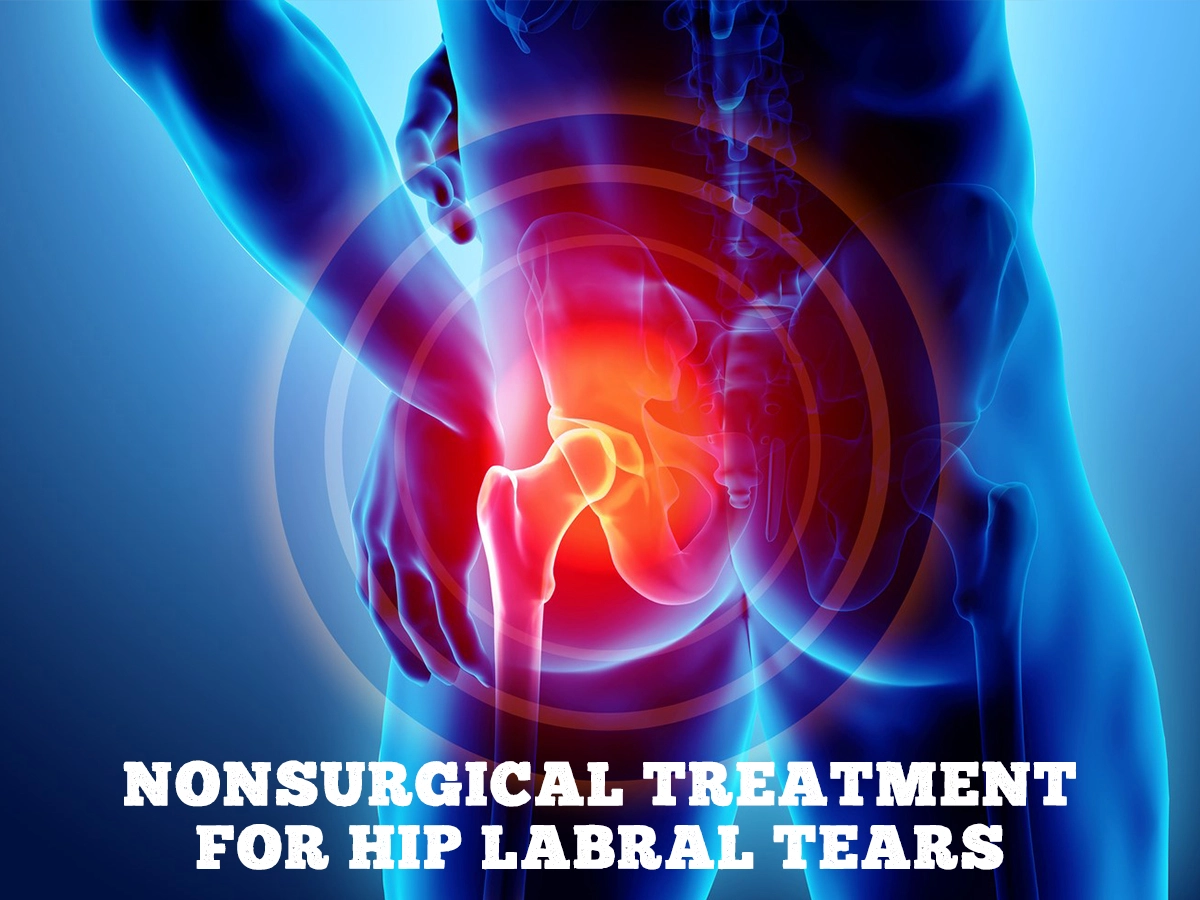
As we walk, run or even sprint through life, one of the areas where we deploy our muscles and joints the most is around the hip region. Just think of it, you use your hips while walking, getting up, sitting down, etc. As long as you’re moving, you’re using your hip muscles in one way or the other. Simultaneously, you are at a high risk of straining or tearing muscles and tissues in this area if you indulge in a sudden, jerky motion or strenuous exercise, athletics, etc. One such injury you risk when straining your hip muscles is a hip labral tear. Now, a hip labral tear often results from an injury to the soft tissue or cartilage that covers the acetabulum or socket of the hip. You can find many options for hip labral tears online, including surgical and non-surgical treatments. The recommended course of treatment depends upon the extent of the injury, and other factors like age, profession, existing health conditions, etc. Here we will focus on nonsurgical treatment for hip labral tears that incorporate holistic healing.
If you are reading this article, it probably means that you have already been experiencing some hip pain accompanied by a popping or clicking sound every time you move your hip. If you haven’t seen a doctor yet, but suspect that you may have a hip labral tear, we will educate you about this injury, how it occurs, and the signs and symptoms.
Last but not least, we will also show you how you can use a holistic healing regimen to get successful non-surgical treatment for hip labral tears.
What is a Hip Labral Tear?
The hip joint comprises a ball-shaped femoral head located at the top of the femur or the leg bone that fits inside a socket-like structure to allow movement.
A hip labral tear occurs in case of an injury to the soft tissue that covers the socket bone. This soft tissue, also known as the labrum, plays a crucial role in your movement as it cushions the hip joint and helps the femoral head move smoothly within the socket. The tissue also serves as a seal, keeping the ball and the socket connected but not touching.
Any damage to this lining can result in a soft popping or clicking sound every time you move, accompanied by pain and inflammation.
We’ll now move on to the causes that can lead you to seek nonsurgical treatment for hip labral tears.
What Causes a Hip Labral Tear?
A hip labral tear can result due to a variety of reasons and causes, as discussed below:
- Structural Conditions: Certain ailments that cause abnormal hip movement can also result in a hip labral tear. For instance, femoroacetabular impingement is a hip condition in which the femoral head doesn’t fit into the socket, limiting movement and causing long-lasting groin pain. This condition also results in osteoarthritis and hip labral tears.
- Physical Trauma or Injuries: A severe injury or trauma to the hip can also cause a hip labral tear. This type of injury commonly occurs among athletes who play sports with repetitive and high-impact movements like ice hockey, football, golf, soccer, etc. If left untreated, the tear can worsen or become more extensive and impact one’s ability to play the sport.
- Degenerative Health Conditions: Chronic, long-term conditions like osteoarthritis gradually wear down the cartilage between the bones. This weakens the cartilage and makes it more prone to tears, especially in the hip area.
Factors like old age and excessive weight increase the risk of developing osteoarthritis and a hip labral tear. You may have osteoarthritis if you are experiencing pain and stiffness in your knee or hip joint or in more than one area.
Symptoms of a Hip Labral Tear
While a hip labral tear can lead to several further complications, here are the most commonly-experienced signs and symptoms:
- Pain or stiffness in the hip region.
- Pain in the groin or area around the buttocks.
- A loud clicking or locking sound every time you move.
- If you feel off-balance or unsteady on your feet.
- Pain or discomfort when you bend, move, or rotate the hip.
When to See a Doctor
If you experience any of the symptoms mentioned in the previous section for a prolonged period, you should book an appointment with a doctor to get a proper diagnosis.
To determine whether you have a hip labral tear, your doctor will first conduct a medical examination and may even ask you to move your leg or even walk around.
Additionally, your doctor may recommend a few imaging tests to understand better what’s going on inside. These include:
- X-Rays: Your doctor may request an X-ray to confirm whether you have a hip labral tear and to check whether you have any co-existing conditions like osteoarthritis, additional tissue damage, tears, etc.
- MRI: An MRI provides a much clearer and highly detailed picture of a hip labral tear and any adjoining damage. Your doctor may also prescribe an MRI to understand the tear’s severity and recommend the treatment accordingly.
NonSurgical Treatments for Hip Labral Tears
In case of a severe hip labral tear, your doctor may recommend surgery. Yet, in more milder cases, there are several non-surgical options that you should try while keeping surgery as a last resort.
We’ve mentioned some of them for you here below:
-
Get Plenty of Rest
After getting a hip labral tear or any other injury, the most important thing is to get plenty of rest while taking care not to strain the affected area any further.
So it may be time to take a few days off, lie down, and give your body some much-needed rest. Limit your activities to avoid discomfort and anything that causes even a slight twinge of pain.
-
Anti-Inflammatory Drugs
NSAIDs or non-steroidal anti-inflammatory drugs like aspirin or ibuprofen can also provide some relief if you’re suffering from pain and inflammation in the area.
Please Note: Always take NSAIDs after consulting a proper medical professional or your doctor.
-
Fluid Injections
Sometimes, your doctor may recommend fluid injections with a local anesthetic. These are injected directly into the hip joint and are also known as intra-articular injections.
These injections are only recommended if all other measures to alleviate pain fail. Sometimes, a doctor may also recommend a corticosteroid injection if the hip pain increases or the patient has any other hip problems.
-
Physical Therapy
You may sometimes have to undergo physical therapy to strengthen your back, buttocks, and thigh muscles. This, in turn, will help your hip area heal and also provide increased support to the hip joint.
Just make sure you go for a licensed physical therapist with prior experience in dealing with hip injuries. While undergoing therapy, it’s also essential to communicate with your therapist and let them know if a specific movement is hurting your hip or not. Once again, always consult your doctor before going for physical therapy.
Nonsurgical Treatment For Hip Labral Tears (FAQs)
-
Can you heal a hip labral tear without surgery?
Ans. Rest, physical therapy, and anti-inflammatory drugs are all excellent non-surgical options for treating hip labral repairs. Most people with hip labral tears don’t require surgery, although minimally invasive arthroscopic surgery may be necessary for injuries that don’t heal after conservative treatment. At the same time, regenerative treatments like stem cell therapies are gaining traction for holistically repairing major muscle and tissue injuries.
-
How do you fix a torn labrum without surgery?
You can treat minor torn labrum with rest, pain medications, ice packs, and cold compresses. It is critical not to strain the tissue further and give the hip joint some rest. You may require injections, physical therapy, or regenerative stem cell therapy.
-
Can a torn labrum in the hip heal itself?
Ans. Rest and other treatments can help control symptoms of a mild labral tear in the hip, but a hip labral tear won’t heal on its own. Nonsurgical procedures include rest, physical therapy, cold compresses, and medicines that reduce inflammation, i.e., over-the-counter painkillers such as ibuprofen, etc. However, regenerative medicine that uses stem cell therapy can help a torn hip labral repair itself without requiring surgery.
-
What happens if you don’t fix a torn hip labrum?
An. An untreated hip labrum can result in chronic pain and instability and weaken your hip and thigh muscles. Over time, this can inhibit your ability to walk and move.
Get Holistic, Nonsurgical Treatment for Hip Labral Tears at Regenerative Masters!
If you’re suffering from a torn hip labral, but seek nonsurgical treatment for hip labral tears, then the experts at Regenerative Masters are here to help you – Schedule An Appointment
At Regenerative Masters, we believe in treating the patient as a whole, not just their symptoms. To us, each patient is a unique individual with a complex constellation of symptoms, underlying reasons, and initiating factors. We know that we must treat the emotional, energetic, physical, neurological, and structural causes of your problem to achieve your fullest recovery.
Regenerative and cellular treatments, sports medicine, functional medicine, naturopathy, hypnotherapy, physical therapy, upper cervical chiropractic, rolfing, nutrition, psychology, and personal training are a few examples of the disciplines we practice to help our patients.
If you want to learn more about how our experts can help you recover from a torn hip labrum, please do not hesitate to reach out to our team at 612-800-5096 today!
